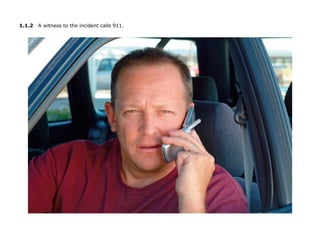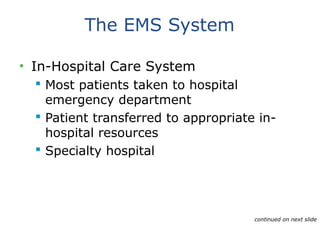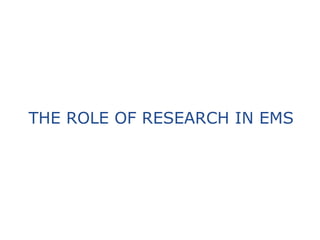EMR ch1
- 3. The EMS System • Timeline of formal system for responding to emergencies • American Civil War "corpsmen" trained to provide care for immediate life threats (bleeding).
- 6. Table 1.1 EMS Time Line continued on next slide
- 7. Table 1.1 (continued) EMS Time Line
- 8. Figure 1.1 Examples of early ambulances used to transport ill and injured patients. (© AP Images)
- 15. Table 1.2 Levels of EMS Education
- 16. The EMS System • Emergency Medical Responder (EMR) Member of EMS system trained in first aid care who helps EMTs at emergency scene
- 19. The EMS System • EMS Models Fire-based • Services and infrastructure operated by local fire department or consortium Third-service • Operated by non-fire government or privately owned ambulance services Hospital-based • Operated by large hospital or group of hospitals
- 20. The EMS System • Scope of Practice Identifies duties and skills EMS provider is legally allowed to perform Defined by state and/or regional statutes and regulations Defines related licensing, credentialing, and certification
- 21. The EMS System • Activating the EMS System 911 call to emergency dispatcher who sends responders Caller may need to dial seven-digit number for ambulance, fire, police, or rescue personnel. Enhanced 911
- 22. 1.1.1 A person becomes injured in a vehicle collision.
- 23. 1.1.2 A witness to the incident calls 911.
- 24. The EMS System • Activating the EMS System 911 calls automatically directed to public safety answering point (PSAP) Emergency Medical Dispatchers (EMDs) receive special training and provide prearrival instructions to callers.
- 26. 1.1.4 Emergency Medical Responders arrive to assist the patient.
- 27. The EMS System • Activating the EMS System Resources dispatched EMS personnel provide care at scene and during transport. Deliver patient to medical facility
- 28. 1.1.5 EMTs continue care and transport the patient to the hospital.
- 29. 1.1.6 Once at the hospital, care is transferred to the emergency department personnel.
- 30. The EMS System • In-Hospital Care System Most patients taken to hospital emergency department Patient transferred to appropriate in- hospital resources Specialty hospital continued on next slide
- 34. The EMS System • Medical Direction EMS Medical Director • Assumes responsibility for direction and oversight of all patient care EMRs act as designated agents of Medical Director. continued on next slide
- 36. The EMS System • Medical Direction Off-line medical direction • Standing orders or protocols On-line medical direction • Direct contact through phone or radio
- 39. The Emergency Medical Responder • EMRs are trained to: Access and assess the patient Provide emergency care Move patients without causing further injury
- 40. 1.2.1 Emergency Medical Responders working as part of a search-and-rescue team.
- 41. 1.2.2 Emergency Medical Responders serving as lifeguards at a recreational area.
- 42. 1.2.3 Many law enforcement personnel receive Emergency Medical Responder training.
- 43. 1.2.4 Emergency Medical Responders also serve on industrial Medical Emergency Response Teams.
- 44. 1.2.5 Emergency Medical Responders are often used to support large events such as NASCAR.
- 45. 1.2.6 Emergency Medical Responders also serve on specialized response teams such as hazmat and rescue teams.
- 46. The Emergency Medical Responder • Roles and Responsibilities Primary concern is personal safety. Personal Protective Equipment (PPE) • Disposable protective gloves • Barrier devices • Protective eye wear • Special face masks • Gowns or aprons
- 47. The Emergency Medical Responder • Patient-related duties Size-up scene Determine chief complaint Lift, move, or reposition patient Transfer patient and patient information Protect patient's privacy Maintain confidentiality Be patient's advocate
- 48. 1.3.1 One of the duties of an Emergency Medical Responder is to safely gain access to the patient.
- 49. 1.3.2 The Emergency Medical Responders must act quickly to find out what is wrong with the patient.
- 50. 1.3.3 Emergency Medical Responders must learn to safely lift and move patients when necessary.
- 51. 1.3.4 The Emergency Medical Responder will often assist EMTs and other transport personnel at the scene of an emergency.
- 52. The Emergency Medical Responder • Traits Keep emergency care skills sharp and current. Attend continuing education and regularly practice skills. Keep uniform neat and clean. Approach patient with respect. Be willing to deal with people. continued on next slide
- 53. The Emergency Medical Responder • Traits Be respectful and accepting of patient's rights. Be honest and realistic but tactful. Be professional and compassionate. Maintain focus on patient. Resolve stressful calls with communication.
- 54. Figure 1.2 Frequent training promotes a high standard of care for your patients.
- 55. The Emergency Medical Responder • Equipment, Tools, and Supplies Blood pressure cuff, stethoscope, oxygen-delivery systems, suctioning equipment Specialized kits for trauma and medical emergencies and childbirth
- 56. The Emergency Medical Responder • Continuous Quality Improvement Continuous improvement in quality of product or service being delivered. EMS product is patient care. Every component within a system can be improved. Submit accurate, complete patient care reports.
- 58. Disaster Assistance • Disaster Medical Assistance Team (DMAT) Specialized teams designed to provide medical care following disaster Deployed on moment's notice if disaster strikes in United States
- 60. THE ROLE OF RESEARCH IN EMS
- 61. The Role of Research in EMS • Research is systematic investigation to establish facts. • Organizations gather and verify research that defines how EMS providers practice emergency care.
- 62. Figure 1.3 Staying current with the latest research is an important aspect of being a good Emergency Medical Responder.
- 63. Think About It • How has research influenced emergency care? • Why is it important for treatment guidelines, based on research, to be uniform across the nation? • How can the application of research and its results be improved?
Editor's Notes
- #17: Talking Point: EMR is the entry level of practice, and additional levels of training exist in the system.
- #20: Talking Point: Although different EMS Models exist, all share the goal of responding as efficiently and effectively as possible.
- #21: Talking Point: Discuss the various levels of providers in your state. Discussion Question: How does the EMR level in your state vary from the other provider levels in your system?
- #22: Discussion Question: How is the EMS system activated in your community? Instructor Notes: Enhanced 911 is the most desirable system because it allows the communication center to automatically receive caller info.
- #25: Discussion Question: Is a formal EMD system established in your community?
- #28: Teaching Tip: Describe a call from start to finish (activation of 911 to transfer of care at the hospital). Provide details of a tiered response that includes EMRs. Discuss the importance of each level.
- #31: Discussion Question: What specialty hospitals are available in your area?
- #35: Discussion Question: What are the components of oversight in your system? Consider local, regional and state. Class Activity: Introduce a system medical director or state EMS official to the class. Discuss the role that s/he plays within the system.
- #37: Discussion Question: What are the components of oversight in your system? Consider local, regional and state. Class Activity: Introduce a system medical director or state EMS official to the class. Discuss the role that s/he plays within the system.
- #47: Discussion Question: Why is it so important that the EMR ensure personal safety?
- #48: Instructor notes: Sizing up the scene allows the EMS provider to determine the number of patients, cause of injury or illness, the need for additional resources. This is a good time to become aware of potential dangers and consider how the scene may continue to change during treatment of the patient. Determine the patient's chief complaint by gathering information from the patient, bystanders, and the scene itself Lift, move or reposition the patient only if it is necessary for patient and provider safety. Transfer care of patient and information that has been gathered to the providers with a higher level of training. There is a moral and legal responsibility to protect your patient's information and medical condition. Only share this information with the EMS providers you are turning patient care over to. Be a patient advocate by doing whatever is best for him as long as the conditions remain safe. Talking Point: Discuss the laws regulating EMS, especially as it applies to patient confidentiality. Indicate where providers may access these laws.
- #53: Teaching Tip: Discuss the character traits EMRs need and how EMRs can improve them. Critical Thinking: Ask students to define professionalism in their own terms, using specific examples.
- #54: Discussion Question: If we have rules, laws, and written oversight, why is professionalism important? Critical Thinking: How might an EMR's professionalism be important to you if you (or one of your parents/children) were a patient?
- #56: Talking Point: EMRs rarely carry medical equipment or supplies; but when they do, the kits are specific to the activities in the EMR environment. Discussion Question: What are some examples of specialized kits and in what settings may they be used? (e.g., medical kits for large group gatherings, trauma kits for sporting events)
- #57: Class Activity: Introduce an EMS representative responsible for the local continuous quality improvement (CQI) process and discuss the role CQI plays in the EMS system.
- #59: Critical Thinking: Why is it important to have a commonly understood and organized means of responding to large-scale disasters?
- #62: Talking Point: Discuss the role research plays in improving emergency care.
- #64: Teaching Tip: Review current research and how it influences the care given by EMRs. Class Activity: Assign a peer-reviewed EMS article. Discuss its implications for practice as an EMR.

































































